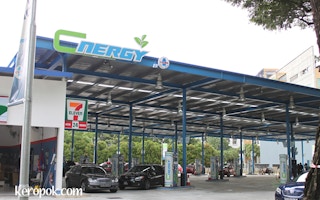Four years ago, Mr Teo Kiang Ang had high hopes for compressed natural gas (CNG) when he opened the world’s largest CNG refuelling station in Old Toh Tuck Road.
He envisioned the 7,066 sq m facility - with 46 pumps - getting a counterpart in the eastern part of Singapore and his taxi company Trans-Cab operating a fleet of 8,000 CNG cabs by 2014.
Today, those dreams are dashed and he has switched gear.
Fewer than half of his 4,500-strong fleet run on CNG, there is no second station, and he has applied to the Government to convert his Toh Tuck premises to office space.
Mr Teo, who also owns cooking gas bottler Union Energy, said he may build his company’s headquarters on the site.
“We still have about 2,000 CNG taxis,” he said. “But in about three to four years, we will have none.”
His dim view of CNG reflects how swiftly the popularity of the gas as an automotive fuel has fizzled out.
The number of CNG vehicles has been shrinking since the Government imposed a tariff on CNG in January last year, and replaced the previous Green Vehicle Rebate with a carbon-based incentive scheme.
The duty closed the gap between the prices of gas and traditional fuels, while the incentive plan reduced rebates for CNG cars, which the Government concluded were not significantly cleaner than petrol-driven cars.
Industry players and analysts also cite other reasons for CNG’s fading presence.
Said Mr William Aw: “Singapore is the only place in the region where diesel is cheaper than CNG, so fleet operators like bus companies found no benefit in converting.” He recently sold his share in CNG refueller Smart Energy, which operates two other CNG stations. A fourth, on Jurong Island, is operated by Sembcorp and is inaccessible to most users.
The pump price of CNG is about $1.73 a litre - 3.5 per cent higher than diesel and 21 per cent lower than 95-octane petrol, both of which are pre-discount prices.
In early 2009, CNG was 30 per cent cheaper than diesel and 43 per cent lower than 95-octane petrol. Often, the two conventional fuels also offer better efficiency.
Said Mr Aw: “It’s sad. I believe in energy diversification. We can’t rely on petrol and diesel alone. I hope there’ll be a revival in interest and support for CNG.”
But taxi operator and vehicle importer Neo Nam Heng is not optimistic. Fewer than 10 per cent of his fleet of about 900 Prime Taxi cabs run on CNG, down from 75 per cent in 2009.
“We’ve converted most of them to run only on petrol,” he said, adding that CNG cabs break down more often and had to be refuelled more frequently. Also, CNG stations are few and far between.
Mr Gilbert von der Aue of C Melchers, an engineering company that is a leading supplier of CNG conversion kits and expertise, said CNG “cannot work without government support”.
“There were plans to roll out gas pipelines but so far, there are gas pipes in only the western part of Singapore,” he added.
Agreeing, executive director Clarence Woo of the Asian Clean Fuels Association said: “You can’t leave new things to market forces. Without a strong (political) champion, it’s hard for them to take off.”

















